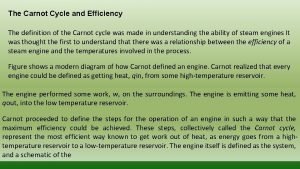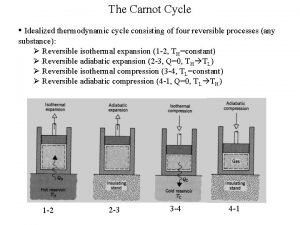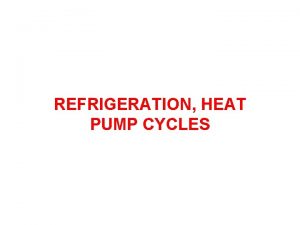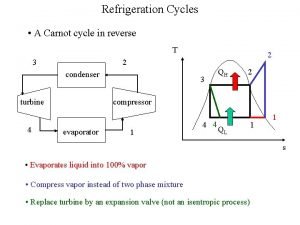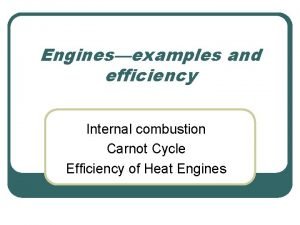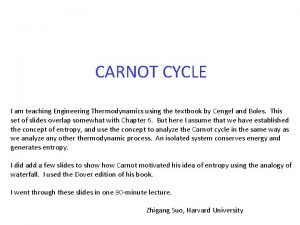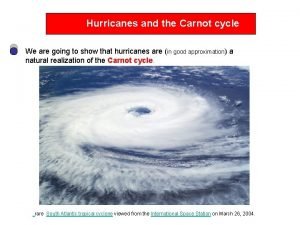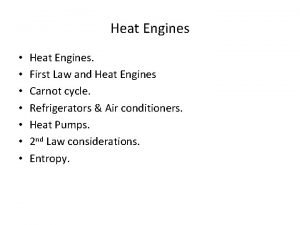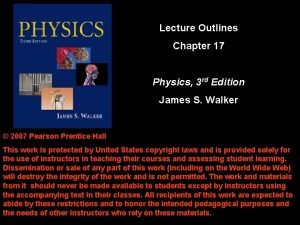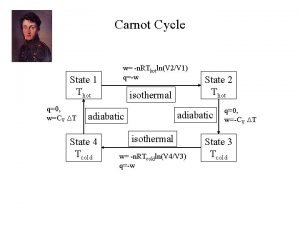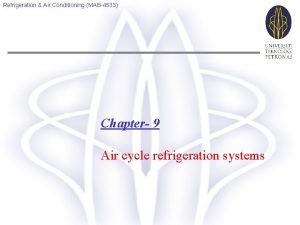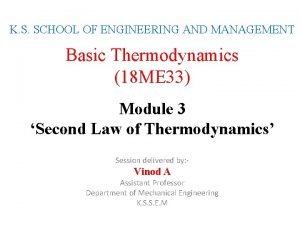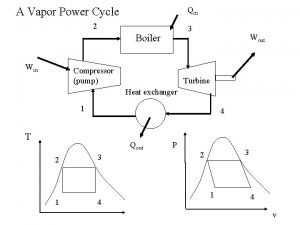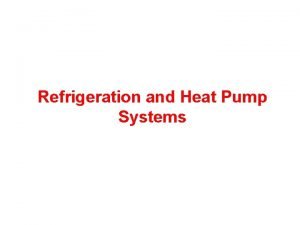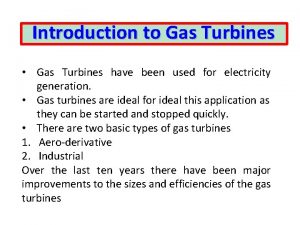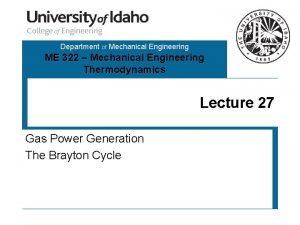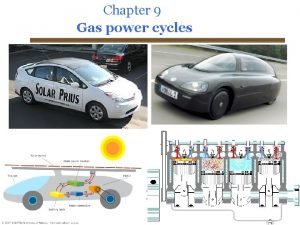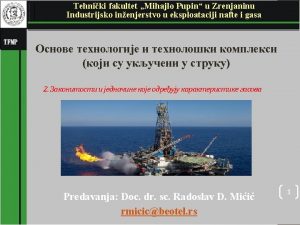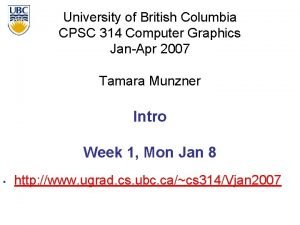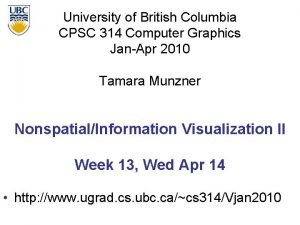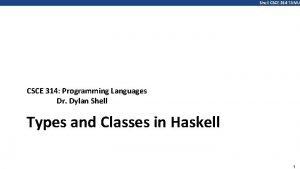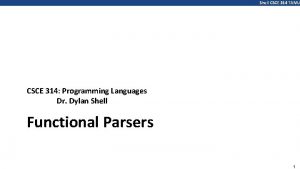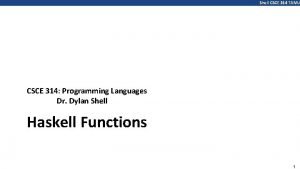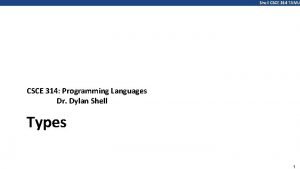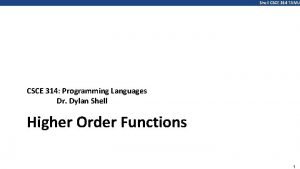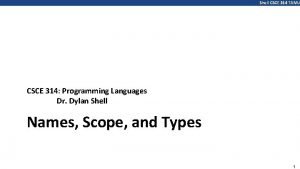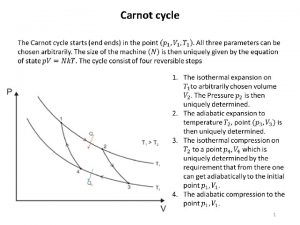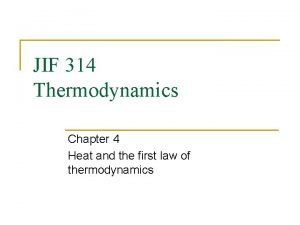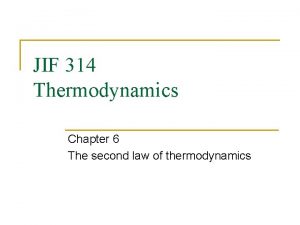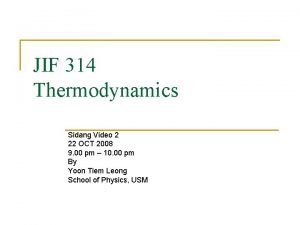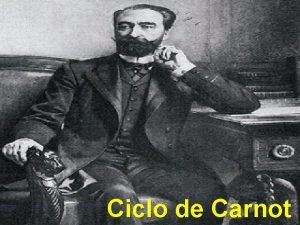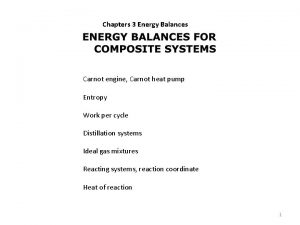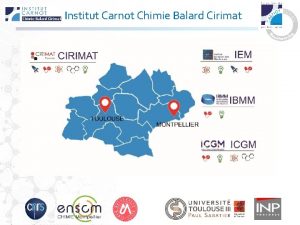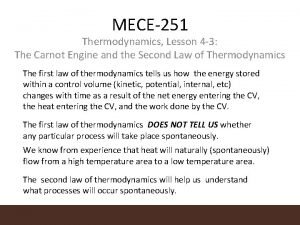JIF 314 Thermodynamics Chapter 7 The Carnot Cycle





























- Slides: 29

JIF 314 Thermodynamics Chapter 7 The Carnot Cycle and thermodynamic temperature scale

Conversion of work into heat and vice versa n n n Consider a heat engine. A heat engine is one that turns heat into work in a cyclic manner. The heat engine interacts thermally with the surroundings, which consists of a high-temperature reservoir, HTR (at constant temperature TH), and a low-temperature reservoir, LTR (at constant temperature TH). The heat engine system at initial state i absorbs heat by the amount |QH| from HTR, turning part of this heat into work |W|, and the balance of heat, |QL| =|QH| -|W|, is rejected into the LTR. After the rejection of |QL|, the heat engine’s state will resume to the initial state i.

Heat engine operating in a cycle High-temperature reservoir at TH |QH| is absorbed by system from HTR state i Intermediate state m 1 Intermediate state m 2 |QL| is rejected by system to LTR Low-temperature reservoir at TL |W| work is done by system as an output

Thermal efficiency of a heat engine n n n At the end of a complete cycle, d. U =0 (since the state of a heat engine returns to its initial one at the conclusion of the cycle) Thermal efficiency = work output/heat input Thermal efficiency will be 100% only if |QL|=0

Kelvin-Planck statement of the second law n n n “It is impossible to construct an engine that, operating in a cycle, will produce no effect other than the extraction of heat from a reservoir and the performance of an equivalent amount of work” In plain language, it means it is impossible to have a machine that can convert totally all heat absorbed from a HTR into work without rejecting any heat back to the LTR. The conversion of heat into work must associated with at least certain minimal effect such a rejection of heat into LTR.

Consequence of Kelvin-Planck statement to heat engine n Heat engine could never achieve 100% efficiency since |QL| can never be zero.

Example of heat engines: The gasoline engine n n n n n 6 processes, out of which 4 are ‘strokes’, 2 are heat transfer processes. Otto cycle describes an idealised gasoline engine Referring to the Otto cycle, the states transition are in the sequence … 1 2 3 4 5 1… The subsequent states are connected via thermodynamic equations 5 1, 1 5, P 0 V=n. RT 1 1 2, adiabatic compression, T 1 V 1 g-1=T 2 V 2 g-1 2 3, heat absorbed |QH|= 3 4, adiabatic expansion, T 3 V 2 g-1=T 4 V 1 g-1 4 1, heat rejected |QL|=

Figure 6 -1

Thermal efficiency of Otto heat engine n Real gasoline engine would have a much less the efficiency of the idealised Otto engine, which set the upper limit of thermal efficiency to any real gasoline engine

Air-standard idealised diesel engine n n In comparison to gasoline engine, the process 2 3 of an air-standard diesel engine is an isobaric heat absorption while the volume expands quasi-statically 2 3 is a horizontal line in Otto’s while it’s a vertical line in Diesel’s.

Figure 6 -2

The steam engine n Figure 6 -3(a), 6 -3(b)

The steam engine n Figure 6 -3(a), 6 -3(b)

Refrigerator n n n The reverse of a heat engine is a refrigerator – it absorbs heat |QL| from a LTR by pumping work |W| into the system, and then ejects heat of the amount |QH| to HTR. For a refrigerator, |QL|+|W|=|QH| A refrigerator is to extract as much heat |QL| as possible from the LTR to a HTR with the expenditure of as littler work |W| as possible.

Refrigerator operating in a cycle High-temperature reservoir at TH |QH| is rejected by system into HTR Intermediate state m 1 Intermediate state m 2 State i |QL| is absorbed by system from LTR Low-temperature reservoir at TL |W| work is done on the system as an input

Clausius statement of the second law n n “It is impossible to construct a refrigerator that, operating in a cycle, will produce no effect other than the transfer of heat from a low-temperature reservoir to a higher temperature reservoir” Put in plain language: Heat does not flow spontaneously from a LTR to a HTR. Work is always necessary to transfer heat in such a heat transfer process.

Equivalence of the Kelvin-Planck statement and Clausis statements n n Using the language of logics, it can be shown that both statements are equivalent, i. e. one statement implies the other, and vice-versa. Read page 156 yourself.

Definition of reversibility n n n In practice, all natural process involve conversion of energy from one form to another, W Q U. A reversible process is one that is performed in such a way that, at the conclusion of the process, both the system and the local surroundings may be restored to their initial states without producing any changes in the rest of the universe. A process that does not fulfilling these stringent requirements is said to be irreversible. Example: A system of gas expands and then contracts to its original volume, without any change in thermodynamic coordinates of the gas system + the that of the rest of the universe. Such would constitute an reversible process. Question: Are natural processes reversible?

Most natural processes are not reversible n n Most representative natural processes are not reversible Most natural processes, particularly those macroscopic processes, involves performance of work into internal energy, a process that can be categorised into two classes, as followed:

Two large classes of processes involving performance of work 1) Isothermal transformations of work done through a system (which remains unchanged) into internal energy of a reservoir. Heat flows through the boundary of the system during such processes. See Fig. 6. 9. 2) Adiabatic transformation of work into internal energy of a system. Heat does not flow through the boundary of the system during such processes. See Fig. 6. 10.



2 nd law of thermo infers non-reversibility in processes involving transformation of work into internal energy n n Both generic types of processes are not reversible due to the second laws of thermodynamics. Read page. 159 Zemansky for the arguments leading to such conclusion.

Dissipative effect n n In the processes mentioned previously, (i. e. processes involves performance of work into internal energy), the conversion of work into internal energy is described as “work is ‘dissipated into internal energy”. Dissipative effects are necessary to transform work into internal energy of a system. Without these dissipative effects, no transformation of work into internal energy is possible. Example of dissipative effects: friction, viscosity, inelasticity, electric resistance, magnetic hysteresis. In most natural process, dissipative effect is always present and it cannot be totally eliminated.

Dissipative effect (cont. ) n n n n n A generic natural process usually involve the conversion of forms of energy. In particular, the conversion of energy form from work into internal energy, Wf = DU can only happen in the presence of an agent of dissipation, e. g. friction or viscosity. Say, consider a moving object with kinetic energy K is subjected to frictional force, f. The force is responsible to dissipate the kinetic energy of the object into internal energy. The frictional force f, being an agent of conversion, converts the kinetic energy into internal energy: DK DU. Should there be no friction, no conversion of kinetic energy into internal energy is possible. In the conversion of DK DU, the amount of work done by the force f is equal to the change of the kinetic energy of the object, i. e. DU is the increase of internal energy of the system + that of the environment. Due to the nature of all dissipative effect, it is not possible to convert all K solely into the internal energy of the system (i. e. the moving object) with no dissipation into ‘the rest of the universe’. Once dissipated into ‘the rest of the universe’, the energy cannot be recovered in practice for work-performing purpose. In other words, dissipative effect always contribute to ‘wastage’ of useful energy into some of form of internal energy that cannot be recovered.

All natural processes are non-reversible n n n n As a consequence of the pervasive presence of dissipative effect in all natural processes, which necessarily involve conversion of the form Wf DU, exhibit irreversibility. Such irreversibility due to the presence of dissipative effect is called mechanical irreversibility. As a conclusion, we revise the logic leading to mechanical irreversibility: Most representative natural processes involves conversion of work into internal energy. Dissipative effect is always present in such processes. Hence, these processes exhibit mechanical irreversibility. The statement of 2 nd law on macroscopic processes is closely related to the fact that dissipative effect can never practically be totally eliminated from such processes.

Perpetual machine of the third kind n n n Imagine an heat machine without any ‘dissipative effect’ of any sort. Such an imaginary machine can convert all energy into work without any work dissipated into internal energy. Such an imaginary perpetual machine that has no friction is called ‘perpetual machine of the third kind’.

Questions to arouse your curiosity n What is perpetual machines of the first and second kind?

What are the necessary conditions for reversibility? n n n 1) Thermodynamical equilibrium AND 2) No dissipative effects Both conditions must be satisfied if reversibility is to be achieved. It is not possible to satisfied these conditions perfectly in practice Hence, in nature all processes are irreversible
 Define carnot engine
Define carnot engine Subtext example
Subtext example Plato persuasive appeal
Plato persuasive appeal Average jif percentile
Average jif percentile Carnot efficiency
Carnot efficiency Difference between refrigerator and heat pump
Difference between refrigerator and heat pump Reverse refrigeration cycle
Reverse refrigeration cycle Carnot engine animation
Carnot engine animation Carnot cycle
Carnot cycle Hurricane carnot engine
Hurricane carnot engine Carnot engine animation
Carnot engine animation Carnot cycle efficiency depends upon
Carnot cycle efficiency depends upon Entropy of diamond
Entropy of diamond Cop of reversed brayton cycle
Cop of reversed brayton cycle Reversed carnot cycle
Reversed carnot cycle Carnot vapor power cycle
Carnot vapor power cycle Coefficient of performance of refrigerator
Coefficient of performance of refrigerator What is brayton cycle in thermodynamics
What is brayton cycle in thermodynamics What is brayton cycle in thermodynamics
What is brayton cycle in thermodynamics What is brayton cycle in thermodynamics
What is brayton cycle in thermodynamics Chapter 5 two-cycle and four-cycle engines answers
Chapter 5 two-cycle and four-cycle engines answers Amagatov zakon
Amagatov zakon Cpsc 426
Cpsc 426 Cpsc 314
Cpsc 314 Csce 314
Csce 314 Csce 314
Csce 314 Csce 314 tamu
Csce 314 tamu Tamu csce 314
Tamu csce 314 Tamu csce 314
Tamu csce 314 Csce 314
Csce 314
